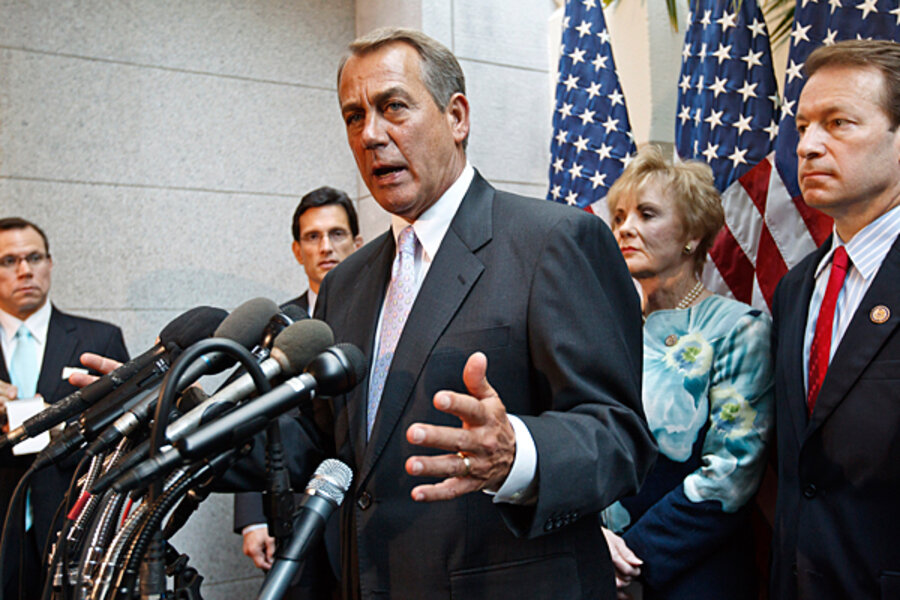GOP outlines two ways to keep rates low on student loans; Democrats see 'ruse'
Loading...
| Washington
Republicans in Congress Thursday proposed extending lower rates on federally subsidized student loans, but what was touted as a tentative step forward soon appeared to be two steps backward.
GOP leaders on Capitol Hill sent President Obama a letter that lays out two possible ways to pay for a one-year extension of lower loan rates, saying they drew on suggestions from Mr. Obama's own budget proposal.
While the letter was couched in bipartisan terms, a spokesman for House minority leader Nancy Pelosi called the missive “a complete and utter ruse."
Until now, the parties have deadlocked on finding the $6 billion it would take to prevent student loan interest from doubling – from 3.4 percent to 6.8 percent – come July 1. The Republican-led House passed a repeal of a portion of Obama's health-care reform law dealing with preventative and public health, while the majority Democrats in the Senate proposed closing a particular payroll tax loophole. The Senate, however, has been unable to find a consensus position on the issue, and Obama said he would veto the House measure.
The Republicans’ first proposal is a 1.2 percent increase in federal employee retirement contributions that would shave $8 billion off the deficit by 2017. The Obama administration had proposed that measure as part of its overall federal budget, while House Republicans had passed a five percent increase in federal employee contributions as a means to offset the looming cost of the budget sequester.
Alternatively, the Hill's GOP leaders said a combination of limiting the length of the interest subsidy to the period students are in school ($475 million savings through 2017), lowering a threshold for taxing Medicaid providers ($4.65 billion in that same time), and improving the collection of pension information from states and localities to prevent overpayment ($358 million) would likewise do the budgetary trick.
Sending of the letter capped a small-scale Capitol Hill drama Thursday around student loans.
First, several news outlets reported, House Speaker John Boehner (R) told a closed House caucus meeting Thursday morning that the student loan fight was “phony” and that it was unlikely Congress would be able to prevent rates from doubling by the July 1 deadline.
That brought Sen. Chuck Schumer (D) of New York into the fray, restating Senate Democrats' top criticism of their House GOP colleagues: They're simply out to block everything.
“These overheard comments by Speaker Boehner confirm our suspicions that Republicans were never serious about wanting to stop rates from doubling on college students," Mr. Schumer said in a statement. "It seems he would rather let costs rise on middle-class families than work across the aisle to find a bipartisan solution. In the Senate, we are going to persist in finding a compromise.”
Mr. Boehner’s spokesman, Michael Steel, fired back at Schumer, criticizing the Senate for failing to pass any legislation and pointing out that Congress could retroactively lower the loan rate, even after July 1.
The Republicans’ letter to Obama was signed by Boehner, majority leader Eric Cantor, Senate minority leader Mitch McConnell and minority whip Jon Kyl.
"The policies in both options are either policies that you recommended in their entirety or a subset of a policy you recommended. We are prepared to support either option," the letter concludes. "There is no reason we cannot quickly and in a bipartisan manner enact fiscally responsible legislation."
Pelosi spokesman Drew Hammil was not so sanguine.
"In the privacy of his Republican Conference meeting this morning, the Speaker said that he will abandon efforts to prevent student loan interest rates from doubling by July 1," Mr. Hammil said. "This letter is nothing than a damage control effort to try to hide the disdain the House Republican leadership continues to show for the millions of American students who are struggling to afford to pay for college.”





